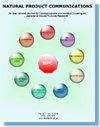Analysis of Glucosinolates and Phenolic Content in Sprouts of 7 Brassica rapa Subspecies
IF 1.4
4区 医学
Q4 CHEMISTRY, MEDICINAL
引用次数: 0
Abstract
Objective: Brassica rapa is an important source of phytochemicals essential for plant defense and human health. To better understand their metabolic characteristics, this study aimed to investigate the glucosinolates and phenolic content from sprouts of 7 B. rapa subspecies. Methods: Glucosinolates and phenolic compounds were extracted using previously reported procedures, with slight modifications. Glucosinolates were identified based on their high-performance liquid chromatography peak area ratios and quantified based on the peak areas, retention time, and response factor and phenolic compounds were identified based on retention times and spiking tests and quantified concerning a corresponding calibration curve. Results: Statistical analysis showed that Choy sum (31.82 ± 2.3 mg/g DW) and Bok choy (31.73 ± 1.49 mg/g DW) presented the highest total glucosinolates content, and the lowest content was observed in Turnip rape (21.75 ± 1.67 mg/g DW). Between the contents of individual glucosinolates, progoitrin presented the highest content in Bok choy (17.84 ± 1.24 mg/g DW). The highest concentration of total phenolic compounds was found in the sprouts of Chinese cabbage (2.7 ± 0.05 mg/g DW), whereas the lowest concentration was found in Choy sum sprouts (2.17 ± 0.05 mg/g DW). The highest individual phenolic content was observed for benzoic acid (0.96 ± 0.03 mg/g DW) and rutin (0.85 ± 0.03 mg/g DW), which were highest in mizuna and Chinese cabbage, respectively. Conclusion: Subspecies may influence the levels of glucosinolates and polyphenols in vegetables. The results of our study showed the distinctive metabolic signatures embedded in the 7 B. rapa subspecies.7 个甘蓝亚种芽中的葡萄糖苷酸盐和酚类物质含量分析
目的:芸苔属植物是植物防御和人类健康所必需的植物化学物质的重要来源。为了更好地了解它们的代谢特征,本研究旨在调查 7 个芸薹属亚种的新芽中葡萄糖苷酸盐和酚类物质的含量。研究方法葡萄糖苷酸盐和酚类化合物的提取采用以前报道过的程序,并略作修改。根据高效液相色谱峰面积比鉴定葡萄糖苷酸盐,并根据峰面积、保留时间和响应因子进行定量;根据保留时间和加标试验鉴定酚类化合物,并根据相应的校准曲线进行定量。结果表明统计分析显示,菜心(31.82 ± 2.3 毫克/克(干重))和大白菜(31.73 ± 1.49 毫克/克(干重))的总葡萄糖苷酸含量最高,萝卜菜(21.75 ± 1.67 毫克/克(干重))的含量最低。在单个葡萄糖苷酸含量之间,大白菜中原苷含量最高(17.84 ± 1.24 毫克/克(干重))。大白菜芽中总酚类化合物的浓度最高(2.7 ± 0.05 毫克/克(干重)),而菜心芽中的浓度最低(2.17 ± 0.05 毫克/克(干重))。苯甲酸(0.96 ± 0.03 毫克/克(干重))和芦丁(0.85 ± 0.03 毫克/克(干重))的单个酚含量最高,分别在水菜芽和大白菜中含量最高。结论亚种可能会影响蔬菜中葡萄糖苷酸盐和多酚的含量。我们的研究结果表明,7 个 B. rapa 亚种的代谢特征各不相同。
本文章由计算机程序翻译,如有差异,请以英文原文为准。
求助全文
约1分钟内获得全文
求助全文
来源期刊

Natural Product Communications
工程技术-食品科技
CiteScore
3.10
自引率
11.10%
发文量
254
审稿时长
2.7 months
期刊介绍:
Natural Product Communications is a peer reviewed, open access journal studying all aspects of natural products, including isolation, characterization, spectroscopic properties, biological activities, synthesis, structure-activity, biotransformation, biosynthesis, tissue culture and fermentation. It covers the full breadth of chemistry, biochemistry, biotechnology, pharmacology, and chemical ecology of natural products.
Natural Product Communications is a peer reviewed, open access journal studying all aspects of natural products, including isolation, characterization, spectroscopic properties, biological activities, synthesis, structure-activity, biotransformation, biosynthesis, tissue culture and fermentation. It covers the full breadth of chemistry, biochemistry, biotechnology, pharmacology, and chemical ecology of natural products.
Natural Product Communications is a peer reviewed, open access journal studying all aspects of natural products, including isolation, characterization, spectroscopic properties, biological activities, synthesis, structure-activity, biotransformation, biosynthesis, tissue culture and fermentation. It covers the full breadth of chemistry, biochemistry, biotechnology, pharmacology, and chemical ecology of natural products.
 求助内容:
求助内容: 应助结果提醒方式:
应助结果提醒方式:


